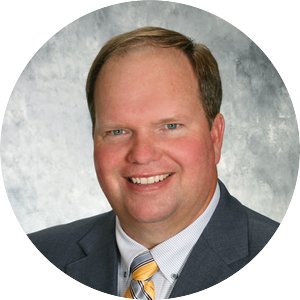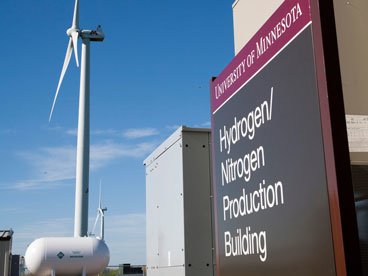
Taking the lead in green ammonia
The U of M's West Central Research and Outreach Center in Morris is a forerunner in the development and use for green ammonia
By WCROC communications
The U of M West Central Research and Outreach Center (WCROC) in Morris has been a forerunner in the development and use for "green ammonia” since 2013 when the first-in-the-world renewable hydrogen and ammonia pilot plant was commissioned. The novel pilot plant uses wind power from a 1.65 MW wind turbine to produce up to 25 tons of nitrogen fertilizer (anhydrous ammonia) each year on-site, which is enough to cover approximately 300 acres of cropland. Hydrogen and nitrogen are combined to form anhydrous ammonia – a core nitrogen fertilizer across the Midwest.
The need for green nitrogen fertilizer is a key element to improving the carbon footprint within production agriculture. Traditionally, the agricultural industry consumes an immense amount of fossil fuel in the production of food, feed, and fiber, which can cause economic and environmental strains. By using green ammonia for fertilizer, fuel and heat, farming’s fossil energy footprint could decrease as much as 90 percent for corn and small grain crops. This is especially important for food processors and retailers.

The WCROC’s work in the area of green ammonia is gaining attention at both the state and national levels. In 2021, the WCROC was granted a $10 million appropriation from the Minnesota Legislature to conduct research and development of the use of anhydrous ammonia as a fuel for power generation. WCROC is working with colleagues across the University on these efforts developing engine generator systems that use ammonia as a fuel. In 2022, Minnesota Governor Tim Walz issued Executive Order 22-22, directing state agencies to pursue federal funding for clean hydrogen market development in Minnesota. In the order, Governor Walz states “Development of hydrogen markets in Minnesota would build on successes such as those seen at the University of Minnesota’s West Central Research and Outreach Center in Morris, which has been a global leader in the early-stage development of unique production pathways for using renewable wind energy to generate green hydrogen and low-carbon ammonia for nitrogen fertilizers.” Also, in 2022, WCROC was part of a national team that received $12.5 million of funding from the US Department of Energy ARPA-E REFUEL program to develop the next generation ammonia production facility powered by wind and solar energy. Development has begun on this next generation pilot production system and WCROC will be the host site.
At the national level, WCROC’s director of operations and green ammonia lead, Mike Reese, received a special invitation from the White House to attend President Biden’s visit to the Cummins’ hydrogen electolyzer production facility in Fridley on April 4, 2023. Among those in attendance, were Minnesota Governor Tim Walz and U.S. Senators Amy Klobuchar and Tina Smith.

“Attending the event was fulfilling in many ways. On a personal level whether one agrees or disagrees with the administration’s policies, it is an honor to meet a U.S. president. During his remarks, the President discussed opportunities for using hydrogen produced from wind and solar and new policies that support and enable these efforts. On a professional level, having been involved in the research and development of these technologies for over 20 years, it is gratifying to see new policies that bring significant opportunities for hydrogen-based systems such as farmer-owned nitrogen fertilizer production facilities. On a community and state level, being recognized by the President as national leaders is also important from an economic development standpoint. I hope the broader message is that our community is innovative and progressive and that this message eventually leads to business and job creation in Stevens County as well as across the state,” said Reese.
WCROC is continuing to conduct research and development in support of this fledgling green ammonia industry.





